Description
The figures of the ceiling were inspired by medieval bestiaries and libri monstrorum , which contained hybrid figures such as sphinxes, armed tritons, satyrs, dragons, sirens and centaurs. The theme has hidden philosophical and humanist meanings, perhaps suggested by the literati who formed the cardinal's court.
In the center is the genealogical tree of the Della Rovere with two peacocks, which can be seen also at the corners. One of the representations is a nude allegory of Fortune, who rides a dolphin, differently from contemporary Florentine depictions in which she is portrayed on a small boat. There is also a putto on two sea horses going in different directions, a Neoplatonic allegory of the human soul, divided between Good and Evil, according to Marsilio Ficino's 1475 comments to Plato's Symposium . The Weighing of the Soul and the Eagle Defeating the Snake are ancient themes which had been syncretized by the Christian world.
Numerous depictions are of sea creatures, including sirens with two tails, painted while breastfeeding, painting or executing acrobatic dances. They were inspired by the sea thiasus featured in Roman sarcophagi and which was also used by Andrea Mantegna, whom perhaps Pinturicchio met in the building of the Belvedere Palace in the Vatican.
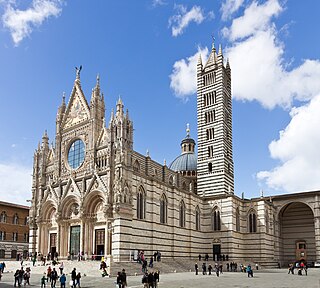
Siena Cathedral is a medieval church in Siena, Italy, dedicated from its earliest days as a Roman Catholic Marian church, and now dedicated to the Assumption of Mary.

The Sistine Chapel ceiling, painted in fresco by Michelangelo between 1508 and 1512, is a cornerstone work of High Renaissance art.

Savona is a seaport and comune in the west part of the northern Italian region of Liguria, capital of the Province of Savona, in the Riviera di Ponente on the Mediterranean Sea. Savona is the main center of the Italian Riviera.

Pinturicchio, or Pintoricchio, also known as Benetto di Biagio or Sordicchio, was an Italian painter during the Renaissance. He acquired his nickname because of his small stature and he used it to sign some of his artworks that were created during the fifteenth and sixteenth centuries.

Ca' Rezzonico is a palazzo and art museum on the Grand Canal in the Dorsoduro sestiere of Venice, Italy. It is a particularly notable example of the 18th century Venetian baroque and rococo architecture and interior decoration, and displays paintings by the leading Venetian painters of the period, including Francesco Guardi and Giambattista Tiepolo. It is a public museum dedicated to 18th-century Venice and one of the 11 venues managed by the Fondazione Musei Civici di Venezia.

The Venus of Urbino is an oil painting by Italian painter Titian, depicting a nude young woman, traditionally identified with the goddess Venus, reclining on a couch or bed in the sumptuous surroundings of a Renaissance palace. Work on the painting seems to have begun anywhere from 1532 or 1534, and was perhaps completed in 1534, but not sold until 1538. It is currently held in the Galleria degli Uffizi in Florence.

The Parish Basilica of Santa Maria del Popolo is a titular church and a minor basilica in Rome run by the Augustinian order. It stands on the north side of Piazza del Popolo, one of the most famous squares in the city. The church is hemmed in between the Pincian Hill and Porta del Popolo, one of the gates in the Aurelian Wall as well as the starting point of Via Flaminia, the most important route from the north. Its location made the basilica the first church for the majority of travellers entering the city. The church contains works by several famous artists, such as Raphael, Gian Lorenzo Bernini, Caravaggio, Alessandro Algardi, Pinturicchio, Andrea Bregno, Guillaume de Marcillat and Donato Bramante.
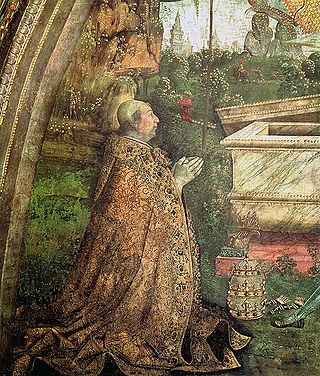
The Borgia Apartments are a suite of rooms in the Apostolic Palace in the Vatican, adapted for personal use by Pope Alexander VI. In the late 15th century, he commissioned the Italian painter Bernardino di Betto (Pinturicchio) and his studio to decorate them with frescoes.

The Palazzo Colonna is a palace in central Rome, Italy, at the base of the Quirinal Hill, and adjacent to the church of Santi Apostoli. It is built in part over the ruins of an old Roman serapeum, and it has belonged to the prominent Colonna family for over twenty generations.

Italian Renaissance painting is the painting of the period beginning in the late 13th century and flourishing from the early 15th to late 16th centuries, occurring in the Italian Peninsula, which was at that time divided into many political states, some independent but others controlled by external powers. The painters of Renaissance Italy, although often attached to particular courts and with loyalties to particular towns, nonetheless wandered the length and breadth of Italy, often occupying a diplomatic status and disseminating artistic and philosophical ideas.
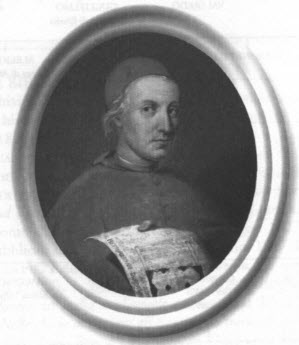
Domenico della Rovere was an Italian cardinal and patron of the arts.

The Cardinal and Theological Virtues is a lunette fresco by Raphael found on the south wall of the Stanza della Segnatura in the Apostolic Palace of the Vatican. Three of the cardinal virtues are personified as statuesque women seated in a bucolic landscape, and the theological virtues are depicted by putti.

The Renaissance in Rome occupied a period from the mid-15th to the mid-16th centuries, a period which spawned such masters as Michelangelo and Raphael, who left an indelible mark on Western figurative art. The city had been a magnet for artists wishing to study its classical ruins since the early 15th century. A revived interest in the Classics brought about the first archaeological study of Roman remains by the architect Filippo Brunelleschi and the sculptor Donatello. This inspired a corresponding classicism in painting and sculpture, which manifested itself in the paintings of Masaccio and Uccello. Pisanello and his assistants also frequently took inspiration from ancient remains, but their approach was essentially cataloguing, acquiring a repertoire of models to be exploited later.

The Albani Torlonia Altarpiece is a painting by the Italian Renaissance painter Pietro Perugino, executed in 1491 and housed in the Torlonia Collection, Rome. It was commissioned by Cardinal Giuliano della Rovere, the future pope Julius II.

Palazzo Della Rovere is a palace in Rome, Italy, facing Via della Conciliazione. It is also known as Palazzo dei Penitenzieri.
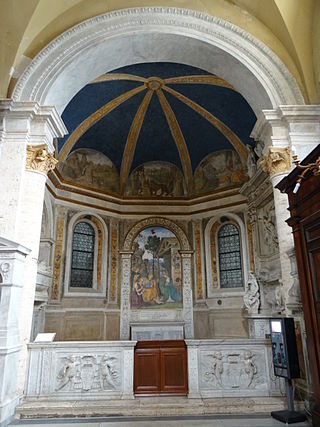
The Della Rovere or Saint Jerome Chapel, otherwise the Chapel of the Nativity is the first side chapel in the south aisle of the Basilica of Santa Maria del Popolo in Rome. It was dedicated to the Virgin and Saint Jerome and decorated with the paintings of Pinturicchio and his pupils. It is one of the best preserved monuments of quattrocento art in Rome.

The Cybo or Saint Lawrence Chapel is the second side chapel in the right-hand aisle of the Basilica of Santa Maria del Popolo in Rome. For the beauty of its paintings, the preciousness of marble revetments covering its walls and the importance of the artists involved in its construction the chapel is regarded one of the most significant sacral monuments erected in Rome in the last quarter of the 17th century.

The Basso Della Rovere or Saint Augustine Chapel is located in the south aisle of the basilica of Santa Maria del Popolo in Rome. This is the third side chapel from the counterfaçade and was dedicated to St. Augustine. The cycle of beautiful quattrocento frescoes was executed by Pinturicchio and his workshop.
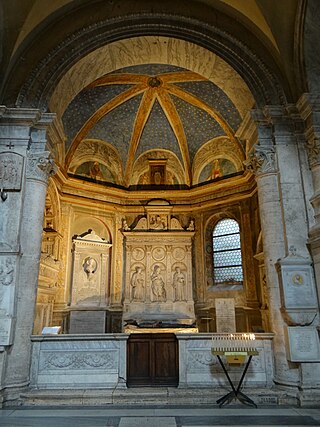
The Costa or St Catherine Chapel is located in the south aisle of the Basilica of Santa Maria del Popolo in Rome. This is the fourth side chapel from the counterfaçade and was dedicated to St Catherine of Alexandria. The lunettes were painted by the helpers of Pinturicchio and the marble altar-piece is attributed to Gian Cristoforo Romano.

Palazzo del Magnifico, also known as Palazzo Petrucci, built as the residence of Pandolfo Petrucci, is located in Siena on Piazza San Giovanni at the corner of Via dei Pellegrini.





















